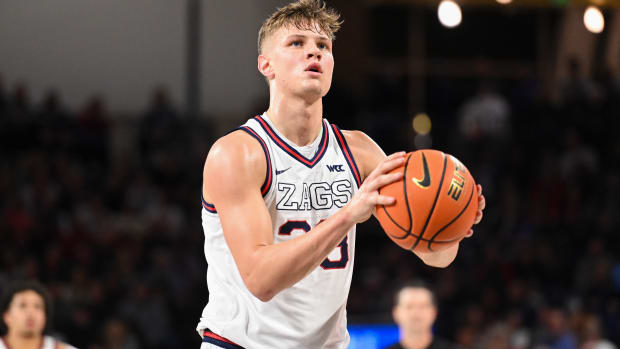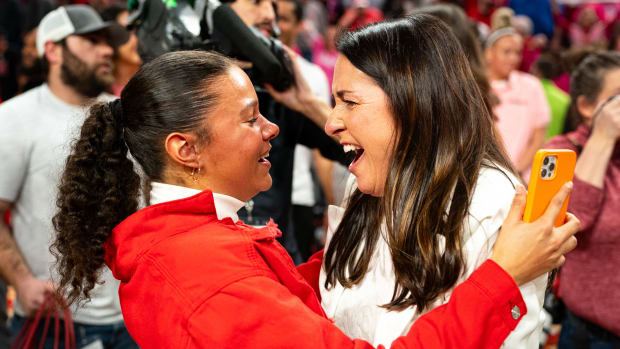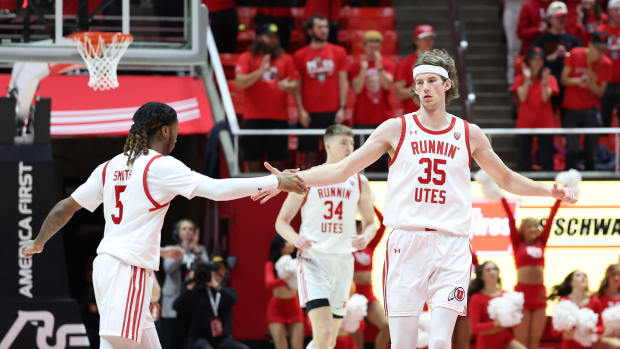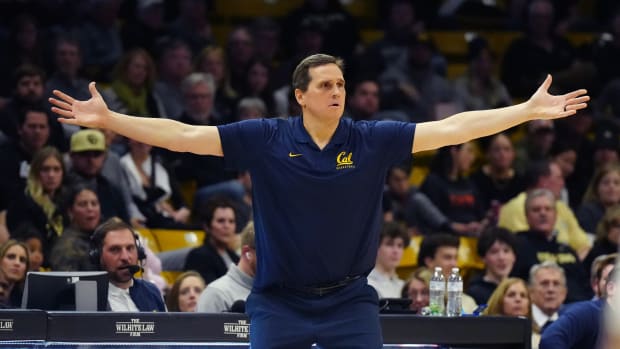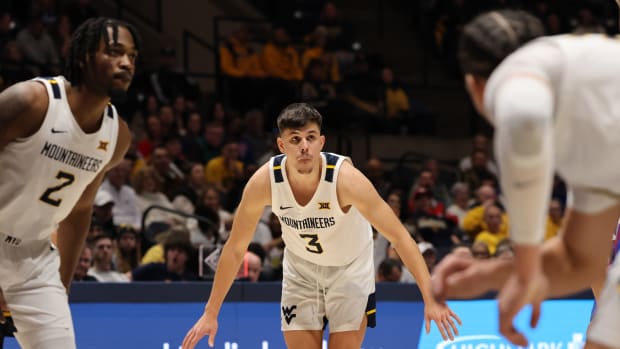Scouting Reports: The Strengths, Weaknesses and X-Factors of College Basketball's Top 10 Teams
SI’s college basketball projection system, now in its fourth year, simulates the season 10,000 times and then ranks teams from 1 to 351 according to their average efficiency. That’s how we got to the top 10, a group of college basketball’s elite programs that includes four Sweet Sixteen teams from a year ago and four of the last six national champions.
The forecast, built by economist Dan Hanner and SI writers Chris Johnson and Jeremy Fuchs, starts with an assessment of every player. For offense, the system projects efficiency and shot volume based on past performance, recruiting rankings, development curves for similar Division I players over the past 14 seasons, the quality of a player's teammates and his coach's ability to maximize talent. That collection of data is weighted based on the team's rotation—including scouting intel on who's expected to play—then used to produce each team's projected offensive efficiency. (The simulations account for variance in individual performances and for potential injuries.) Team defensive efficiency projections are based on the players' projected rebound, steal and block percentages; their height (taller frontcourts make for stingier D); their experience (veterans have fewer lapses); and their coaches' defensive résumés.
Below, SI’s college basketball writers size up the top 10 teams according to our projections, introducing the players that should be household names this winter and singling out an X-factor on each team that could prove to be the deciding factor in who cuts down the nets in San Antonio next spring.
• Complete 1–351 rankings | SI's Preseason All-America Teams | Projected bracket
1. Arizona
SI’s Projections: Second in offensive efficiency (122.0); 19th in defensive efficiency (94.5); First in Pac-12 (15–3)
What You Need to Know: The Wildcats’ immense potential on the court is overshadowed by ominous developments off it. Arizona is one of four programs to have an assistant coach facing federal bribery and fraud charges stemming from an FBI corruption investigation. University president Robert C. Robbins announced in late September that the school had suspended assistant Emanuel (Book) Richardson and “initiated the dismissal process.” (He is appealing his dismissal.)
But as long as the fallout from the inquiry doesn’t affect any players, this season could give Sean Miller a great chance to shed his reputation as the best coach never to reach the Final Four. In Allonzo Trier, he’ll have an efficient, go-to scorer who excels at wrong-footing defenders off the dribble, drawing fouls on basket attacks and draining three-point shots (39.1% in 2016–17). Trier is a national player of the year candidate—but he might not be Arizona’s best player.
That distinction will belong to DeAndre Ayton, a top three recruit from Nassau, Bahamas, who should be in the running for the No. 1 pick in the 2018 NBA draft. Scientists tasked with creating the ideal modern big man in a lab would come up with something like Ayton—a 7-foot, 250‑pound behemoth with an advanced scoring arsenal and the physical tools to develop into a stout defensive anchor. Ayton doesn’t always play hard, but if he’s engaged and in sync with his teammates, there’s not a Pac-12 big man he can’t dominate.
X-Factor: Parker Jackson-Cartwright doesn’t stand out in a rotation stuffed with future pros, but it’s more likely that the steady veteran (99 games at Arizona) will make the Wildcats go. Though undersized at 5' 11", Jackson-Cartwright is a crafty passer who can hit the three (42.3%). — Chris Johnson
Nobody Loses From the Expansion of College Basketball's Pumped-Up Preseason
2. Michigan State
SI’s Projections: Fifth in offensive efficiency (119.8); Fifth in defensive efficiency (92.4); First in Big Ten (14–4)
What You Need to Know: Tom Izzo is usually optimistic about his team, but this year is different. His Spartans have everything they need for him to win his second national championship. That starts inside, a welcome change. Izzo started four guards against Kansas in the second round of last year’s NCAA tournament, which the Spartans lost by 20. And his one starting forward, gifted scorer Nick Ward, politely declined requests to play defense. “Ward is a good player and had a great year offensively,” the ever-candid Izzo says. “I’m not winning big with him unless he changes some.”
Ward will have to change if he wants to keep his minutes. Now Izzo can turn to freshman Jaren Jackson Jr., who looks like he walked right off of an NBA general manager’s holiday wish list: He is 6' 11" with a 7' 4" wingspan and a shot that allows him to stretch defenses. His presence is one of the many reasons for the confidence inside MSU’s basketball offices.
Another big one is national player of the year favorite Miles Bridges, who led the team in scoring last year (16.9 ppg) and will move to small forward. If you add 6' 9" Gavin Schilling, who missed last season with a right-knee injury, and 6' 8", 260‑pound freshman Xavier Tillman, who might have started lifting weights at birth, it’s clear that this team brings back the Michigan State hallmarks of size, D and toughness—and with the most talent Izzo has ever had.
X-Factor: A career 37.1% three-point shooter, Matt McQuaid has the range to do damage from behind the arc. But will MSU’s loaded roster free him for momentum-building daggers, or will he have trouble finding his rhythm as the Spartans’ stars try to share the ball? — Michael Rosenberg
3. Duke
SI’s Projections: First in offensive efficiency (124.2); 46th in defensive efficiency (97.2); First in ACC (14–4)
What You Need to Know: It’s not often that a recruit committing to Duke qualifies as a shocker, but in the case of Marvin Bagley III, the surprise stemmed from the fact that he was committing at all. Originally the No. 1 prospect in the class of 2018, the 6' 11" Bagley abruptly reclassified in August and announced he’d be heading to Durham immediately.
The multidimensional big man with a burgeoning jumper who played at Sierra Canyon High in Chatsworth, Calif., joins a roster already loaded with precocious talent, including three more five-star freshmen in guards Trevon Duval and Gary Trent Jr. and forward Wendell Carter Jr. As with last year’s squad—which was ranked No. 1 in the preseason but was bounced in the NCAA tournament’s second round by seventh-seeded South Carolina—the task for Mike Krzyzewski will be incorporating all of the individual stars into a formidable team.
Duval is a shifty passer and savvy ballhandler who can get to any spot on the floor. That will allow senior Grayson Allen—a 2015–16 All-America who suffered through an injury- and controversy-filled junior season in which he was suspended for (once again) tripping an opponent—to play off the ball and free Trent to spot up for threes. Bagley has the ability to play all three frontcourt spots, making him a matchup nightmare. If he spends what would have been his 12th‑grade spring trimming nets, that won’t come as much of a surprise.
X-Factor: In an injury-plagued freshman season, Marques Bolden played just 6.5 minutes per game. Now at full strength (and following rumors that he was considering transferring), Duke’s best ball-screen defender will be a dangerous weapon—provided he’s healthy enough to stay on the court. — Dan Greene
4. Wichita State
SI’s Projections: Ninth in offensive efficiency (119.0); Sixth in defensive efficiency (92.6); T-First in AAC (15–3)
What You Need to Know: In 10 years under coach Gregg Marshall, the Shockers have developed into one of the premier March giant slayers, but this year they’ll enter the season as one of the giants. Wichita State brings back its top eight scorers from the squad that won 31 games, and it should extend its four-year league-title streak this season even though the team has left the Missouri Valley for the more competitive American Athletic Conference.
No AAC team—including Cincinnati—can come close to the Shockers’ perimeter tandem of sophomore guard Landry Shamet and junior wing Markis McDuffie. Shamet is a smooth pick-and-roll practitioner who held his own against Kentucky’s lottery-bound backcourt of De’Aaron Fox and Malik Monk in the second round of the NCAA tournament last March, while McDuffie is a versatile defender who led the team in scoring (11.5) and rebounding (5.7) last season. Both players are recovering from foot injuries, with Shamet expected to return in mid-November (from a broken foot) and McDuffie in mid-December (from a stress fracture).
In the paint, senior Shaquille Morris gives Wichita State a left-tackle-sized (6' 8'', 279 pounds) frontcourt linchpin who is known for grabbing rebounds and protecting the rim. Improved shooting from inside the arc—the Shockers ranked 120th in that category in 2016–17 (50.5%)—could be the key to earning a second Final Four bid in five years.
X-Factor:Zach Brown has spent his first three seasons focused on defense, but due to injuries, the 6' 6" Houston native will have to shoulder a heavier offensive load, especially in early nonconference matchups against Baylor and Oklahoma, and at the Maui Invitational. — C.J.
Ranking Every Team in College Basketball, From Arizona (No. 1) to Mississippi Valley State (No. 351)
5. Villanova
SI’s Projections: Third in offensive efficiency (120.5); 18th in defensive efficiency (94.4); First in Big East (13–5)
What You Need to Know: The last time most people saw Phil Booth play basketball was nearly 19 months ago, in the biggest and best game of his life, when the guard scored 20 points off the bench to keep Villanova afloat before Kris Jenkins’s buzzer-beating three gave the Wildcats the win in the 2016 national championship. Since then Booth has had more surgical procedures on his left knee (two) than he’s played minutes in Big East conference matchups (zero). “That game,” Booth says of the ’16 championship, “feels forever ago.”
With Booth unavailable and freshman big man Omari Spellman ruled academically ineligible by the NCAA last season, the Wildcats’ rotation shrank to just seven players. Villanova was 320th in the nation in bench minutes, which led to the team’s tempo falling to 324th, easily the slowest of coach Jay Wright’s 16-year tenure. “We couldn’t press, and we walked the ball up a lot because we were trying to conserve energy,” Wright says. “I think we’ll go back to our normal style of play this year. We’ll have the depth to do that.”
That depth is strongest in the backcourt, where Booth, a combo guard who prides himself on stifling defense, joins blossoming scorers Jalen Brunson and Donte DiVincenzo. The three may see the floor together at times, with versatile wing Mikal Bridges floating between the two, three and four. It’s the sort of flexibility Wright hasn’t had in—well, if not forever, then at least too long.
X-Factor: He’s a big-bodied banger on the blocks and a promising shot blocker, and that means Omari Spellman has the same kinds of skills inside that made Darryl Reynolds and Daniel Ochefu fit so well into the Wildcats’ system in recent years. — D.G.
6. Cincinnati
SI’s Projections: 19th in offensive efficiency (116.7); Third in defensive efficiency (92.2); T-First in AAC (15–3)
What You Need to Know: Toughness is a hallmark of Mick Cronin’s teams, and no player better exemplifies this than senior forward Gary Clark. Last March he had half a front tooth knocked out in an AAC tournament semifinal win over UConn. Clark tossed it to a trainer and went back into the game soon after. This fall Clark, who has started 101 of the 103 games he’s played for the Bearcats, will anchor a team that has three starters back after winning 30 games for only the second time in school history. (The 2001–02 team went 31–4.) Last season the 6' 8" Clark averaged 10.8 points, 7.9 rebounds and 2.1 assists while shooting 52.9% from the field, and though he needs to improve his outside game (he shot 28.6% from three-point range), he has no problem mixing it up inside against bigger players.
Clark isn’t flashy, and he’s often overshadowed by his higher-scoring teammates: forward Kyle Washington and Jacob Evans, a smooth wing with a reliable three-point shot (41.8% last season) and the potential to win league player-of-the-year honors. In the backcourt, 6' 5" sophomore Jarron Cumberland will build on an impressive first season in which he shot 49.% from the field. Together they make the Bearcats the most balanced team of Cronin’s tenure. Cincinnati’s roster is so stacked—and so well‑rounded—that an eighth straight NCAA tournament bid and a place in the Elite Eight seem all but inevitable.
X-Factor:Cane Broome was the Northeast Conference player of the year in 2015–16 (23.1 ppg) before transferring from Sacred Heart, and though he won’t reach those numbers in the AAC, he should easily replace Troy Caupain’s production (10.5 points, 4.6 rebounds in ’16–17). — Joan Niesen
7. Kansas
SI’s Projections: 11th in offensive efficiency (118.8); 23rd in defensive efficiency (94.9); First in Big 12 (12–6)
What You Need to Know: Going into the 2015–16 season, Malik Newman was considered a likely one-and-done. Ranked as the country’s No. 10 player by ESPN, he was headed to Mississippi State, where he was expected to be the primary offensive option in coach Ben Howland’s defense-first system. Instead Newman suffered from turf toe, had a lackluster year (11.3 points, 2.8 rebounds), entered and eventually withdrew his name from the NBA draft, and announced he was transferring to Kansas. He sat out 2016–17 and studied one of the country’s best guard duos, Devonte’ Graham and Frank Mason III. Although last season there were concerns that Newman might bolt for the NBA, he is back to help anchor the Jayhawks’ backcourt alongside Graham.
On KU’s summer trip to Italy, Newman averaged 18.5 points over four games, including 32 in the finale against a squad of Italian all-stars, and he’s on the watch list for the Jerry West award, given to the nation’s top shooting guard. At Big 12 media day, Self remarked that Newman had still not regained the “swagger” he had as a high school senior, but the coach is expecting that Newman will take a big step forward once the season officially begins.
Self’s system has always been guard-friendly, and Newman and Graham are the perfect complementary pieces to ensure that the Jayhawks will go on to win a 14th straight Big 12 title.
X-Factor: Before breaking his left wrist last December, Udoka Azubuike was averaging 5.0 points and 4.4 rebounds. Now that the 280-pound sophomore is back to full strength, the Jayhawks will count on him to both rattle the rim with thunderous dunks and to protect it. — Joan Niesen
What-If Projections: How Draft Decisions, Coaching Changes and Commits Impact 2017-18
8. Kentucky
SI’s Projections: 15th in offensive efficiency (118.0); 17th in defensive efficiency (94.3); T-First in SEC (12–6)
What You Need to Know: John Calipari has proved that he doesn’t need upperclassmen to compete for conference and national championships, but the 2017–18 Wildcats will have the least experience of any of the eight teams he’s coached in Lexington. Kentucky has only one rotation player, sophomore forward Wenyen Gabriel (4.6 points), returning from the team that won 32 games, claimed its third–consecutive SEC tournament title and reached the Elite Eight.
The Wildcats reloaded with another top-ranked recruiting class, but none of their seven incoming stars are surefire All-Americas. The strongest candidate for that honor is Hamidou Diallo, a 6' 5'' off-guard who joined the program last January and declared for the draft without ever playing a college game, only to withdraw and return to school as a redshirt freshman. Over the summer, Diallo averaged 10.9 points and 3.9 rebounds with USA Basketball’s U-19 team, which was also coached by Calipari.
The Wildcats will surround Diallo with a cast of long, rangy, freshmen who are not easily categorized into positions, including Kevin Knox, a 6' 9" 3-and-D prototype with a 7-foot wingspan, and Jarred Vanderbilt, a 6' 9" playmaker (who will be out until January with a left-foot injury). Another freshman, 6' 11", 240-pound center Nick Richards, will stabilize the back line of Kentucky’s defense, and five-star prospect Quade Green, a shifty creator off the bounce with the shooting chops to keep defenders on their toes, will likely take over at point guard.
X-Factor: He comes in with less hype than his classmates, but 6' 6" point guard Shai Gilgeous-Alexander will be an important piece on a team heavy on wings and big men. He can initiate the offense or slash to the rim, and he has the length to check every perimeter position. — C.J.
9. Louisville
SI’s Projections: 17th in offensive efficiency (117.7); 13th in defensive efficiency (94.0); T-Second in ACC (13–5)
What You Need to Know: With Rick Pitino fired after 16 seasons in charge, and two assistants placed on administrative leave in the wake of the FBI’s investigation into college hoops recruiting, this season is bound to be filled with turmoil. (Pitino maintains he has no knowledge of an alleged payment given to the family of top recruit Brian Bowen by a Louisville assistant coach.)
But interim coach David Padgett, a 32-year-old who played forward for Pitino from 2005–06 through ’07–08 and joined his staff in ’14, says onlookers shouldn’t expect this year’s team to be all that much different on the court. “The things we’ve been doing the last 15, 16 years have been very successful,” Padgett says. “I think it’d be crazy to try to change it.”
So if opponents thought they’d get a break from the relentless pressure that has helped Louisville rank in the top eight nationally in adjusted defensive efficiency for seven straight seasons, that’s not going to happen. Senior Quentin Snider, a steady-handed point guard who helped lead the Cardinals to the 2015 Elite Eight, will provide continuity on both sides of the ball. “He knows what to do,” Padgett says. “He’s been through it.”
With Bowen suspended indefinitely due to the pending investigation, wing Deng Adel must become the primary scorer for the team. It may take some time for a new normal to set in, but Padgett still has the talent to end the season with a deep run in the NCAAs.
X-Factor: Rick Pitino kept V.J. King on a short leash last season, using him primarily to give wing Deng Adel a breather. King averaged just 5.5 points in 13.5 minutes as a freshman, but this year he’ll be expected to significantly increase that output as he sees more playing time. — D.G.
10. Florida
SI’s Projections: 24th in offensive efficiency (116.3); Seventh in defensive efficiency (94.0); T-First in SEC (13–5)
What You Need to Know: Florida’s trademark this season might be an ability to rain jumpers from the perimeter, but for the Gators’ first few practices in October, most of the shots were hoisted during defensive drills. Coach Mike White knows what he can get offensively from a lineup built around guard KeVaughn Allen (14.0 ppg, 37.0% from three-point range last season), but he wanted to make sure his players understood how many points can be saved by keeping their hands high, filling passing lanes and closing out on shooters. “You want to be clear with what you value more than anything else—with what is most important to your staff and your program,” says White, who led Florida to the Elite Eight in his second season after replacing Billy Donovan. “We start every year with the fundamentals in terms of building our defense.”
That focus will be more important than ever this year. Following the departures of 6' 8" wings Devin Robinson and Justin Leon, the Gators won’t be as long on the perimeter. They’ll have to rely less on athleticism and more on technique and hustle to limit threes and to deflect entry passes into the post. Florida should get a boost in the paint around the time it begins SEC play. That’s when 6' 11" center John Egbunu is expected to return after tearing his left ACL last February. Until then, a committee of young post players will have to learn on the job. As long as they’re embracing their defensive fundamentals, White will be happy. He knows the points will come.
X-Factor: Egor Koulechov, a 6' 5" grad transfer from Rice, hit 47.4% of his three-point attempts last season, and his new teammates have taken to calling him 3-Gor. But coach Mike White has quipped that he’d rather have the Volgograd, Russia, native be known as D-Gor. — Andy Staples
